Discover 35 hidden attractions, cool sights, and unusual things to do in Mumbai (India). Don't miss out on these must-see attractions: Kanheri Caves, Elephanta Caves, and Chhatrapati Shivaji Maharaj Vastu Sangrahalaya. Also, be sure to include Gateway of India in your itinerary.
Below, you can find the list of the most amazing places you should visit in Mumbai (Maharashtra).
Table of Contents
Kanheri Caves
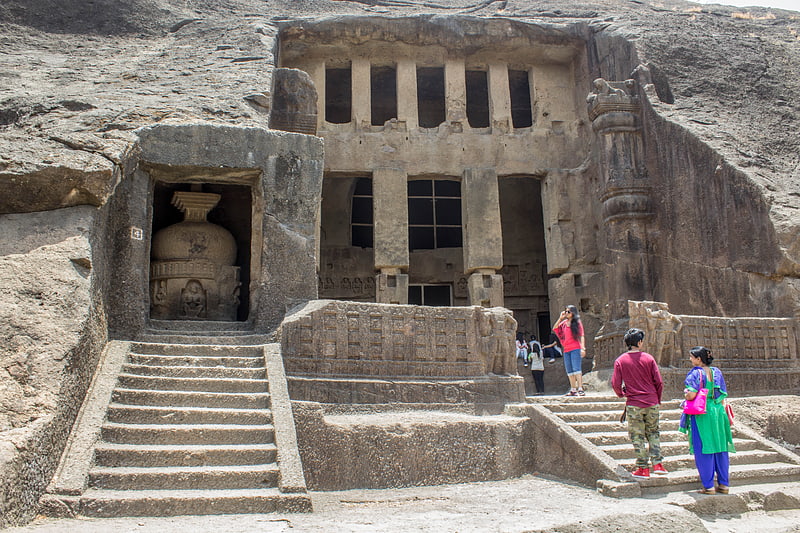
Also known as: कान्हेरी गुफाएँ
Rock hewn temples with Buddhist shrines. The Kanheri Caves are a group of caves and rock-cut monuments cut into a massive basalt outcrop in the forests of the Sanjay Gandhi National Park, on the former island of Salsette in the western outskirts of Mumbai, India. They contain Buddhist sculptures and relief carvings, paintings and inscriptions, dating from the 1st century CE to the 10th century CE. Kanheri comes from the Sanskrit Krishnagiri, which means black mountain.
The site is on a hillside, and is accessible via rock-cut steps. The cave complex comprises one hundred and nine caves. The oldest are relatively plain and unadorned, in contrast to later caves on the site, and the highly embellished Elephanta Caves of Mumbai. Each cave has a stone plinth that functioned as a bed. A congregation hall with huge stone pillars contains a stupa (a Buddhist shrine). Rock-cut channels above the caves fed rainwater into cisterns, which provided the complex with water. Once the caves were converted to permanent monasteries, their walls were carved with intricate reliefs of Buddha and the Bodhisattvas. Kanheri caves were built in the 1st century and had become an important Buddhist settlement on the Konkan coast by the 3rd century CE.
Most of the caves were Buddhist viharas, meant for living, studying, and meditating. The larger caves, which functioned as chaityas, or halls for congregational worship, are lined with intricately carved Buddhist sculptures, reliefs, pillars and rock-cut stupas. Avalokiteshwara is the most distinctive figure. The large number of viharas demonstrates there was a well organized establishment of Buddhist monks. This establishment was also connected with many trade centers, such as the ports of Sopara, Kalyan, Nasik, Paithan and Ujjain. Kanheri was a University center by the time the area was under the rule of the Maurayan and Kushan empires. In the late 10th century, the Buddhist teacher Atisha (980–1054) came to the Krishnagiri Vihara to study Buddhist meditation under Rahulagupta.[1]
Address: in Sanjay Gandhi National Park,, 400103 Mumbai (Kandivali)
Elephanta Caves
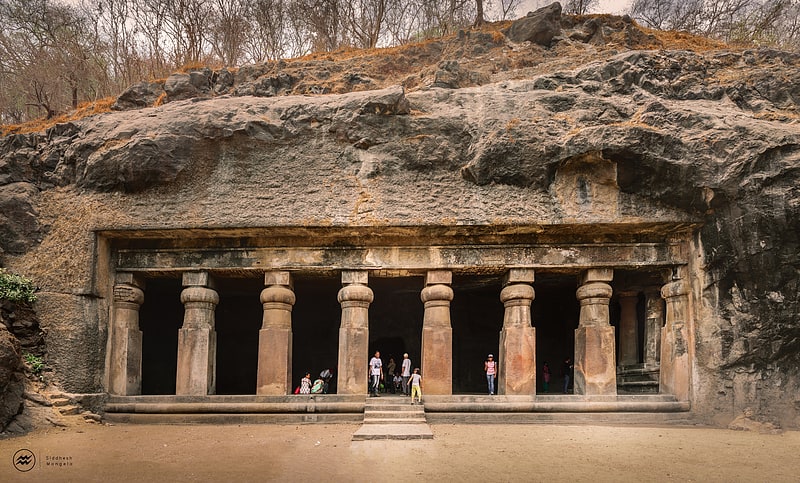
Also known as: घारापुरी गुफाएँ
Island with sculpted cave temples. Designated by UNESCO as a World Heritage Site, the Elephanta Caves are a collection of cave temples predominantly dedicated to the Hindu god Shiva. They are on Elephanta Island, or Gharapuri, in Mumbai Harbour, 10 kilometres east of Mumbai in the Indian state of Mahārāshtra. The island, about 2 kilometres west of the Jawaharlal Nehru Port, consists of five Hindu caves, a few Buddhist stupa mounds that date back to the 2nd century BCE, and two Buddhist caves with water tanks.
The Elephanta Caves contain rock cut stone sculptures, mostly in high relief, that show syncretism of Hindu and Buddhist ideas and iconography. The caves are hewn from solid basalt rock. Except for a few exceptions, much of the artwork is defaced and damaged. The main temple's orientation as well as the relative location of other temples are placed in a mandala pattern. The carvings narrate Hindu mythologies, with the large monolithic 20 feet (6.1 m) Trimurti Sadashiva (three-faced Shiva), Nataraja (Lord of dance) and Yogishvara (Lord of Yoga) being the most celebrated.
These date to between the 5th and 9th centuries, and scholars attribute them to various Hindu dynasties. They are most commonly placed between the 5th and 7th centuries. Many scholars consider them to have been completed by about 550 CE.
They were named Elefante – which morphed to Elephanta – by the colonial Portuguese who found elephant statues on the caves. They established a base on the island. The main cave (Cave 1, or the Great Cave) was a Hindu place of worship until the Portuguese arrived, whereupon the island ceased to be an active place of worship. The earliest attempts to prevent further damage to the caves were started by British India officials in 1909. The monuments were restored in the 1970s. In 1987, the restored Elephanta Caves were designated a UNESCO World Heritage Site. It is currently maintained by the Archaeological Survey of India (ASI).[2]
Address: Elephanta Caves, Mumbai
Chhatrapati Shivaji Maharaj Vastu Sangrahalaya
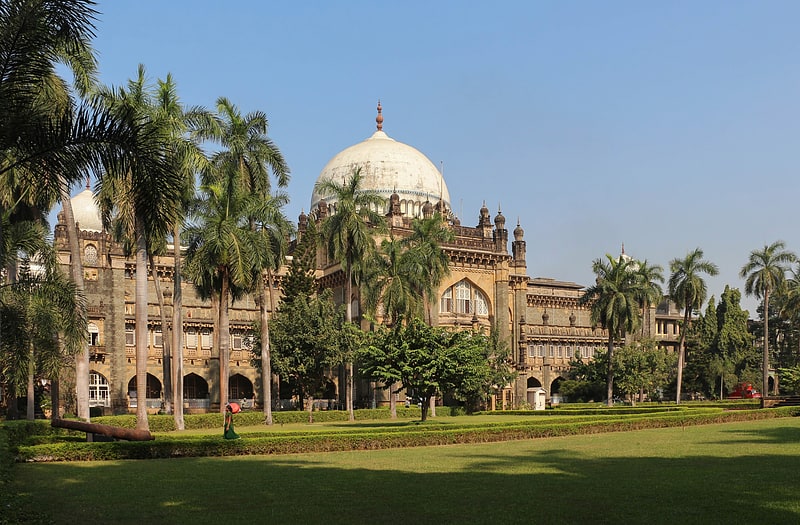
Also known as: छत्रपति शिवाजी महाराज वस्तु संग्रहालय
Museum in Mumbai, India. Chhatrapati Shivaji Maharaj Vastu Sangrahalaya, originally named Prince of Wales Museum of Western India, is a museum in Bombay which documents the history of India from prehistoric to modern times.
It was founded in the early years of the 20th century by prominent citizens of Mumbai, with the help of the government, to commemorate the visit of George V, who was Prince of Wales at the time. It is located in the heart of South Mumbai near the Gateway of India. The museum was renamed in 1998 after Shivaji, the founder of the Maratha Empire.
The building is built in the Indo-Saracenic style of architecture, incorporating elements of other styles of architecture like the Mughal, Maratha and Jain. The museum building is surrounded by a garden of palm trees and formal flower beds.
The museum houses approximately 50,000 exhibits of ancient Indian history as well as objects from foreign lands, categorised primarily into three sections: Art, Archaeology and Natural History. The museum houses Indus Valley Civilization artefacts, and other relics from ancient India from the time of the Guptas, Mauryas, Chalukyas and Rashtrakuta.[3]
Address: 159-161, Mahatma Gandhi Road, 400023 Mumbai (Colaba)
Gateway of India
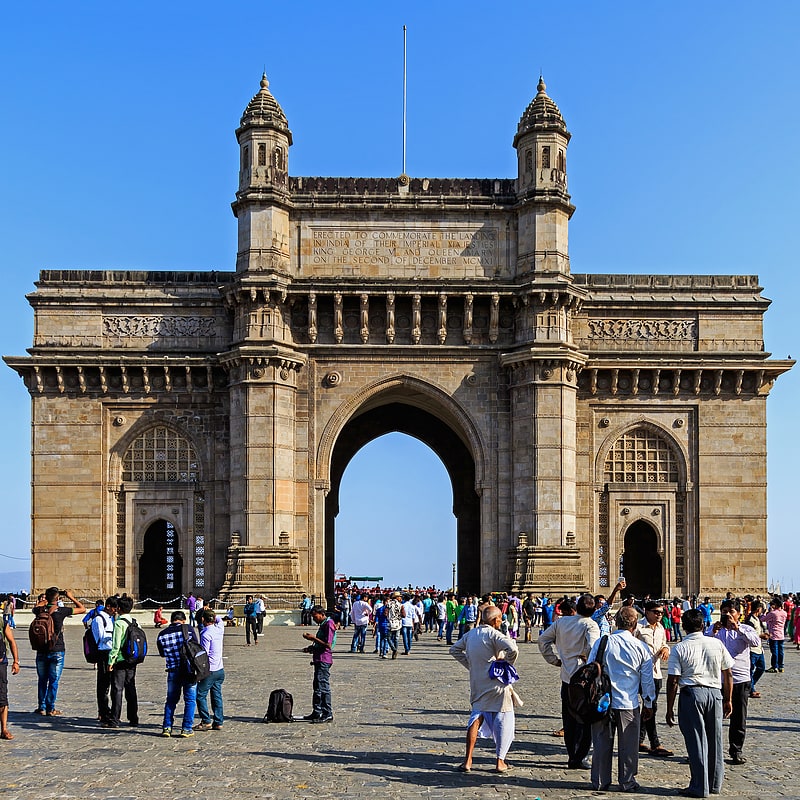
Also known as: गेटवे ऑफ़ इन्डिया
Waterfront Indo-Saracenic triumphal arch. The Gateway of India is an arch-monument built in the early 20th century in the city of Mumbai, India. It was erected to commemorate the landing of King-Emperor George V, the first British monarch to visit India, in December 1911 at Ramchandani Road near Shyamaprasad Mukherjee Chowk.
The foundation stone was laid in March 1913 for a monument built in the Indo-Saracenic style, incorporating elements of 16th-century Gujarati architecture. The final design of the monument by architect George Wittet was sanctioned only in 1914, and construction was completed in 1924. The structure is a memorial arch made of basalt, which is 26 metres (85 feet) high, with an architectural resemblance to a triumphial arch as well as Gujarati architecture of the time.
After its construction the Gateway was used as a symbolic ceremonial entrance to India for important colonial personnel. The Gateway is also the monument from where the last British troops left India in 1948, following Indian independence. It is located on the waterfront at an angle, opposite the Taj Mahal Palace and Tower Hotel and overlooks the Arabian Sea. Today, the monument is synonymous with the city of Mumbai, and is amongst its prime tourist attractions. The gateway is also a gathering spot for locals, street vendors, and photographers soliciting services. It holds significance for the local Jewish community as it has been the spot for Hanukkah celebrations, with the lighting of the menorah, since 2003. There are five jetties located at the Gateway, of which two are used for commercial ferry operations.
The Gateway was the site of a terror attack in August 2003, when there was a bomb blast in a taxi parked in front of it. Access to the gateway was restricted after people congregated at its premises following the 2008 Mumbai terror attacks, in which the Taj Hotel opposite the gateway and other locations in its vicinity were targeted.
In March 2019, the Maharashtra state government proposed a four-step plan to develop the location for the convenience of tourists, following a direction issued by the state governor in February 2019.[4]
Fashion Street
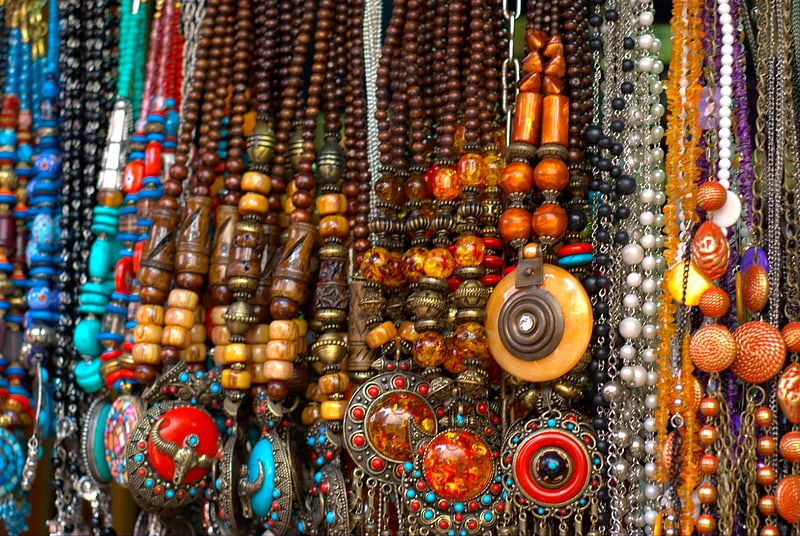
Street in Mumbai, India. Fashion Street refers to a cluster of over 385 street side clothing shops on MG Road near Azad Maidan and is opposite to Bombay Gymkhana, in South Mumbai, India.
The market is located just opposite VSNL office building at Mahatma Gandhi Road. It is a popular tourist destination, and is known for bargaining.
In January 2011, as a part of the green drive of BMC along with Fashion Street Shopowners' Association, the market at Fashion Street stopped the use plastic bags, and switched to paper bag, now they are again using plastics made by the training workshop of the National Association of the Blind.It's a very large shopping place in Mumbai.[5]
Crawford Market
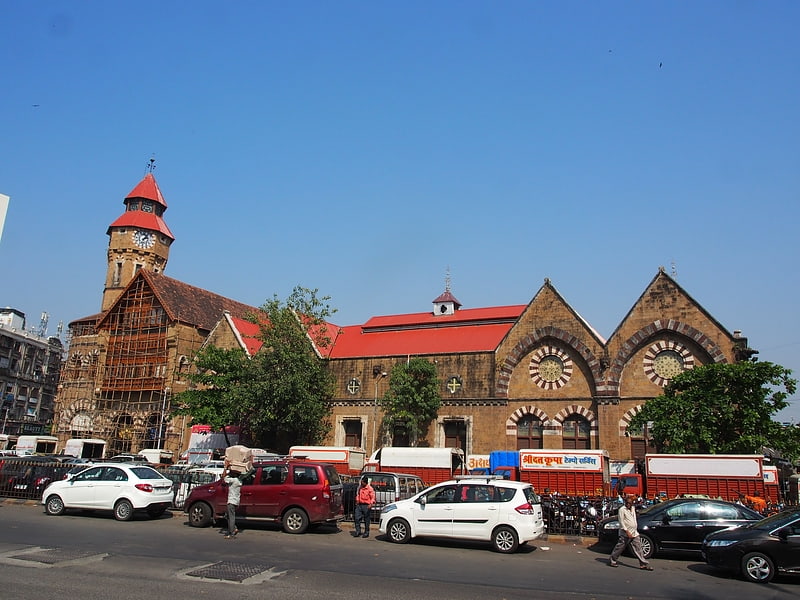
Market in Mumbai, India. Crawford Market is one of South Mumbai's most famous markets. The building was completed in 1869, and donated to the city by Cowasji Jehangir. Originally named after Arthur Crawford, the first Municipal Commissioner of the city, the market was later renamed to honour Maharashtrian social reformer Mahatma Jotirao Phule. The market is situated opposite the Mumbai Police headquarters, just north of Chhatrapati Shivaji Terminus railway station and west of the J.J. flyover at a busy intersection. It was the main wholesale market for fruits in Mumbai until March 1996, when the wholesale traders were relocated to Navi Mumbai.
In 1882, the building was the first in India to be lit up by electricity.[6]
Address: Mohammed Ali Road, 400001 Mumbai (Colaba)
Nehru Science Centre
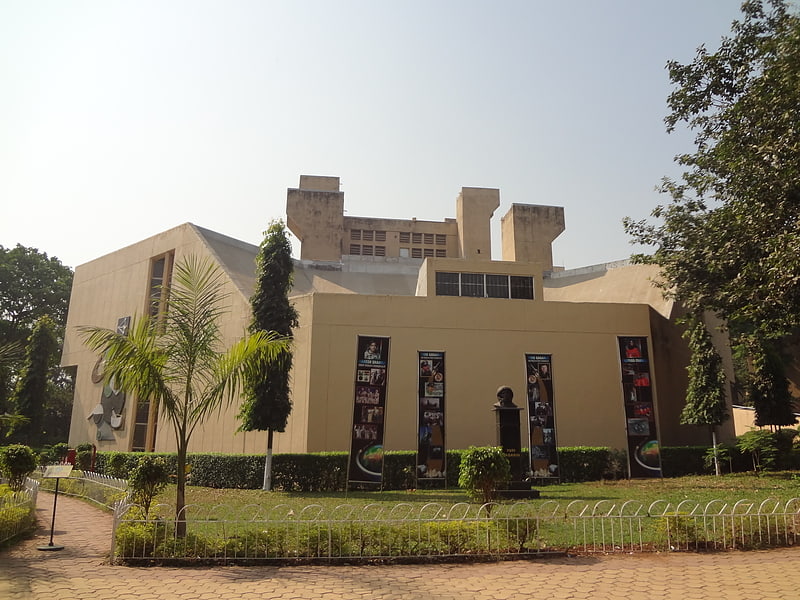
Also known as: नेहरु विज्ञान केंद्र
Museum in Mumbai, India. Nehru Science Centre is the largest interactive science centre in India. It is located in Worli, Mumbai. The centre is named after India's first Prime Minister, Jawaharlal Nehru. In 1977, the centre started with the 'Light and Sight' exhibition, and then in 1979 a Science Park was built. On 11 November 1985 it was opened to the public by Rajiv Gandhi, the then Prime Minister of India.
In 1977, Nehru Science Centre, conceived as a Science & Technology Museum in late sixties, took final shape as India's largest interactive science centre, to match the world trends in such public institutions. The centre opened its first semi-permanent exhibition `Light & Sight' in 1977 followed by the world's first ever Science Park in 1979, during the International Year of the child. On 11 November 1985 the full-fledged science centre was finally opened to public by Prime Minister Rajiv Gandhi.
Nehru Science Centre, the largest Science Centre in the country has a sprawling 8 acres (32,000 m2) of science park with varieties of plants, trees and shrubs. More than 500 hands-on and interactive science exhibits on energy, sound, kinematics, mechanics, transport, etc. are installed in the park. The NSC building, with its unique architecture, houses several permanent science expositions on various theme.
National Council of Science Museums (NCSM), the parent body of Nehru Science Centre, Mumbai, with its 25 science centres / museums all over the country, has the best infrastructure and skilled manpower to conceptualise, design, develop and organise high quality science exhibits and other related educational programmes and activities.
The centre is one of the four national level science museums in NCSM, working as the Western Zone Headquarters with five science centres in Nagpur, Calicut, Bhopal, Dharampur and Goa under its umbrella, caters to the people in the Western part of India. As a part of its activities, the centre organises regular extensive science education programmes, activities and competitions for the benefit of the common people and students in particular.
Every year, the centre is visited by over 750,000 people.
More than 500 hands-on and interactive science exhibits are based on various aspects of science and technology, and there is a collection of some historical artefacts of science and technology. The 3D Science Show is also organised at the centre.
Nehru Science Centre, conceived as a Science & Technology Museum in late sixties, took final shape as India's largest interactive science centre in 1977 to match the world trends in such public institutions. The centre opened its first semi-permanent exhibition `Light & Sight' in 1977 followed by the world's first ever Science Park in 1979, during the International Year of the child. The full- fledged science centre was finally opened to public on 11 November 1985 by Prime Minister Rajiv Gandhi.
National Council of Science Museums (NCSM), the parent body of Nehru Science Centre, Mumbai, with its 29 Science Centres / Museums all over the country, has the best infrastructure and skilled manpower to conceptualise, design, develop and organise high quality science exhibits and other related educational programmes and activities.
The centre is open to the public every day from 10.00 am to 6.00 pm, including Sundays and public holidays, throughout the year except two days: One on the 2nd day of Holi (Dhulandi or the day of colours) and Second on the day of Diwali.[7]
Address: Dr E Moses Rd, 400018 Mumbai (Worli)
EsselWorld

Also known as: एस्सेल वर्ल्ड
Amusement park in Mumbai, India. EsselWorld is an amusement park located in Gorai on Dharavi island, Mumbai. It covers an area of 65 acres along with Water Kingdom, and was opened to the public in 1989. Along with Adlabs Imagica, EsselWorld is one of the largest amusement parks in India.
EsselWorld has been involved in multiple controversies. The original land acquisition for 700 acres was mired in controversy and claimed to be illegal. Additionally, there have been allegations of illegal destruction of mangroves and violation of coastal zone regulations.[8]
Address: Gorai Village,, 400091 Mumbai (Borivali - Dahisar)
Haji Ali Dargah
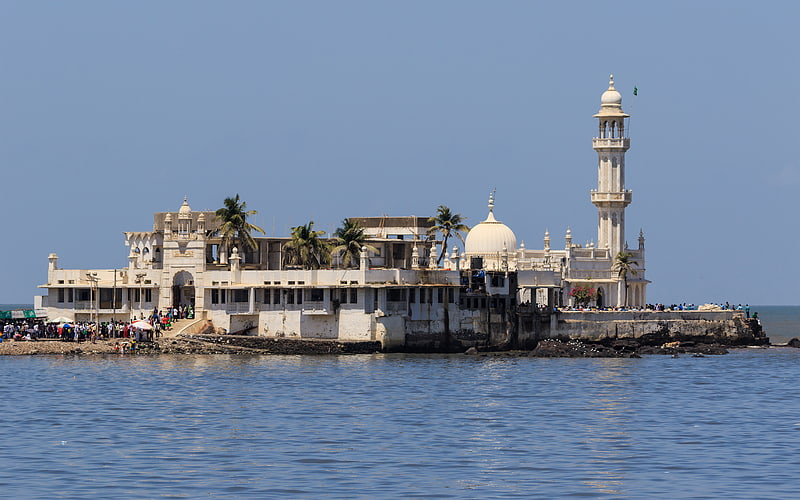
Also known as: हाजी अली की दरगाह
Island mausoleum and pilgrimage site. The Haji Ali Dargah is a mosque and dargah or the monument of Pir Haji Ali Shah Bukhari located on an islet off the coast of Worli in the southern Mumbai.
An exquisite example of Indo-Islamic Architecture, associated with legends about doomed lovers, the dargah contains the tomb of Haji Ali Shah Bukhari. Bukhari was a Sufi saint and a wealthy merchant from Uzbekistan. Near the heart of the city proper, the dargah is one of the most recognisable landmarks of Mumbai.[9]
Address: Dargah Rd, Mumbai
Sanjay Gandhi National Park
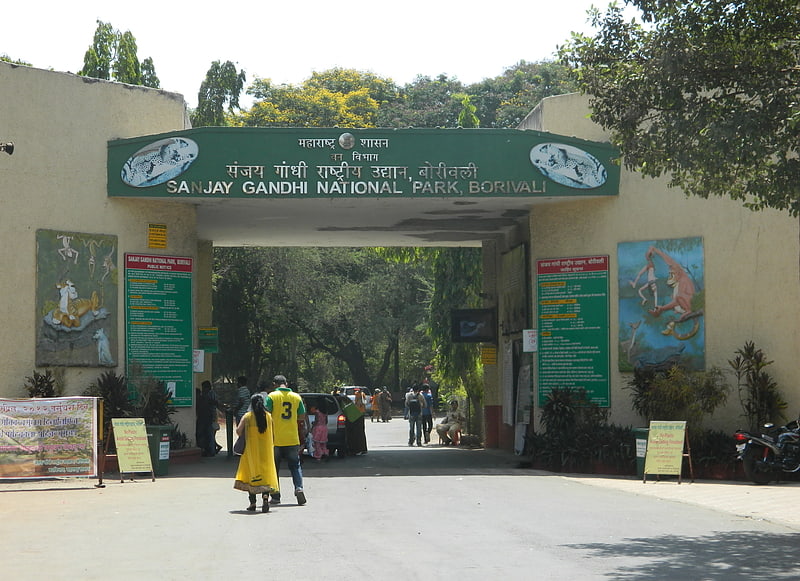
Also known as: संजय गांधी राष्ट्रीय उद्यान
Protected site in India. Sanjay Gandhi National Park is a 87 km2 protected area in Mumbai, Maharashtra State in India. It was established in 1969 with headquarters at Borivali.
The 2400-year-old Kanheri caves sculpted by monks out of the rocky cliffs, lie within the park. The rich flora and fauna of Sanjay Gandhi National Park attract more than 2 million visitors every year.[10]
Rajabai Clock Tower
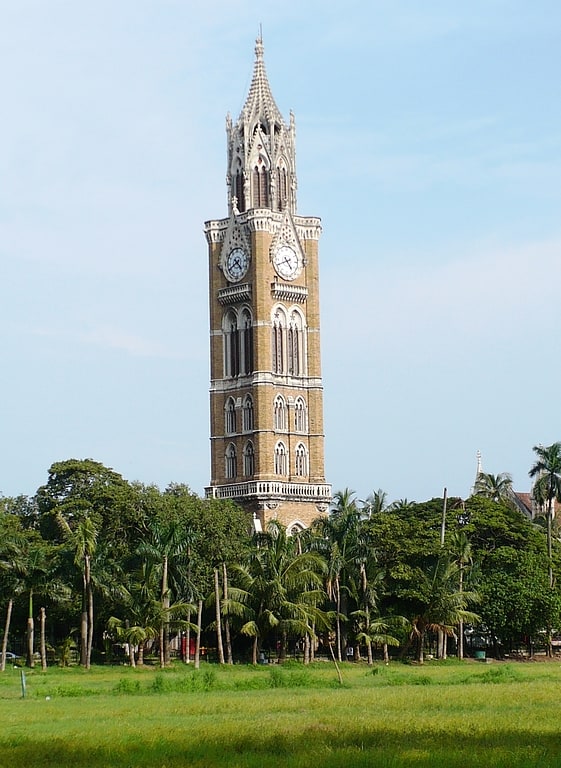
Tower in Mumbai, India. The Rajabai Tower is a clock tower in South Mumbai India. It is in the confines of the Fort campus of the University of Mumbai. It stands at a height of 85 m. The tower is part of The Victorian and Art Deco Ensemble of Mumbai, which was added to the list of World Heritage Sites in 2018.[11]
Address: Bombay University, 400001 Mumbai (Colaba)
Bandra–Worli Sea Link
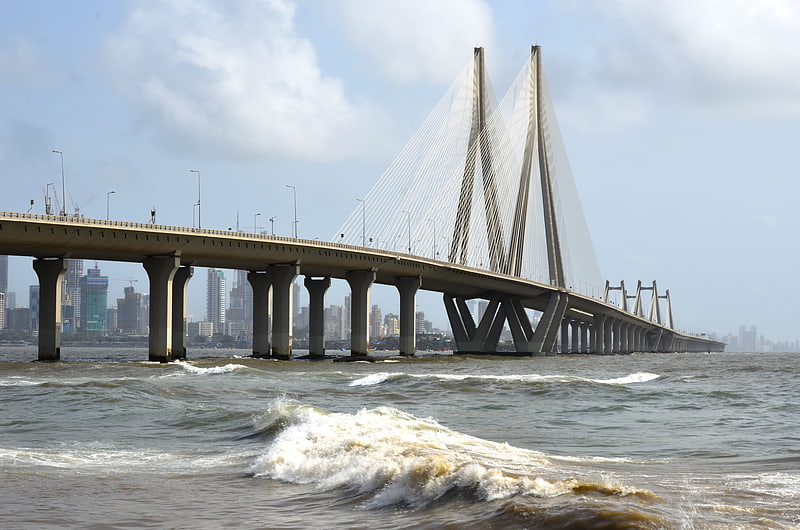
Also known as: बान्द्रा-वर्ली समुद्रसेतु
Cable-stayed bridge in Mumbai, India. The Bandra–Worli Sea Link is a 5.6 km long, 8-lane wide bridge that links Bandra in the Western Suburbs of Mumbai with Worli in South Mumbai. It is the 4th longest bridge in India after Bhupen Hazarika Setu, Dibang River Bridge and Mahatma Gandhi Setu. It is a cable-stayed bridge with pre-stressed concrete-steel viaducts on either side. It was planned as a part of the proposed Western Freeway that would link the Western Suburbs to Nariman Point in Mumbai's main business district, but is now planned to become part of the Coastal Road to Kandivali.
The 1M bridge was commissioned by the Maharashtra State Road Development Corporation (MSRDC), and built by the Hindustan Construction Company. The first four of the eight lanes of the bridge were opened to the public on 30 June 2009. All eight lanes were opened on 24 March 2010.
The sea-link reduces travel time between Bandra and Worli during peak hours from 20 to 30 minutes to 10 minutes. As of October 2009, BWSL had an average daily traffic of around 37,500 vehicles.[12]
Flora Fountain
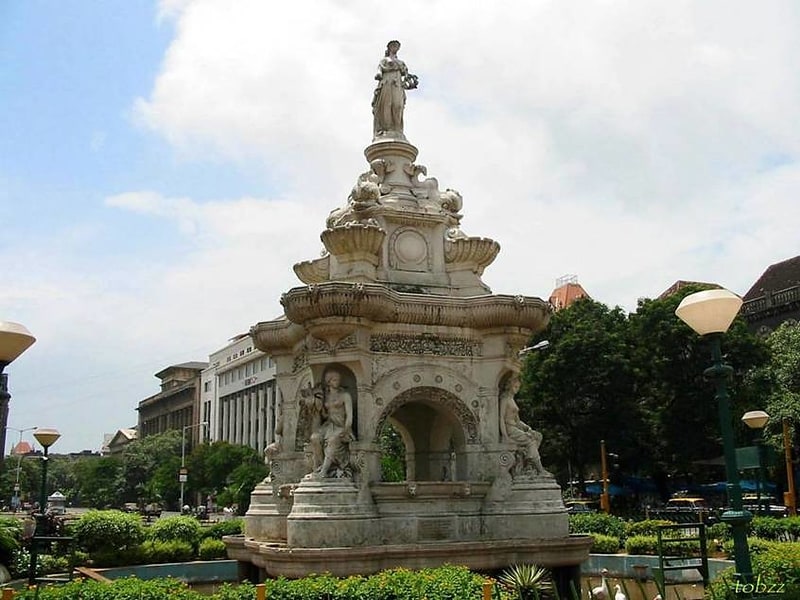
Historical landmark in Mumbai, India. Flora Fountain is a Fountain located at the Hutatma Chowk is an ornamentally sculpted architectural heritage monument located at the southern end of the historic Dadabhai Naoroji Road, at the Fort business district in the heart of South Mumbai, Mumbai, India. Flora Fountain, built in 1864, depicts the Roman goddess Flora. It was built at a total cost of Rs. 47,000, or 9000 pounds sterling, a large sum in those days.[13]
Address: Veer Nariman Road, 400001 Mumbai (Colaba)
Hanging Gardens of Mumbai

Garden in Mumbai, India. The Hanging Gardens, in Mumbai, also known as Pherozeshah Mehta Gardens, are terraced gardens perched at the top of Malabar Hill, on its western side, just opposite the Kamala Nehru Park. They provide sunset views over the Arabian Sea and feature numerous hedges carved into the shapes of animals. The park was designed and laid out in 1881 by Ulhas Ghapokar over Bombay's main reservoir, some say to cover the water from the potentially contaminating activity of the nearby Towers of Silence. When seen from the air, the walkway inside the park, spell out the letters PMG in cursive.[14]
Address: Malabar Hill, 400075 Mumbai (Girgaum)
Dhobi Ghat
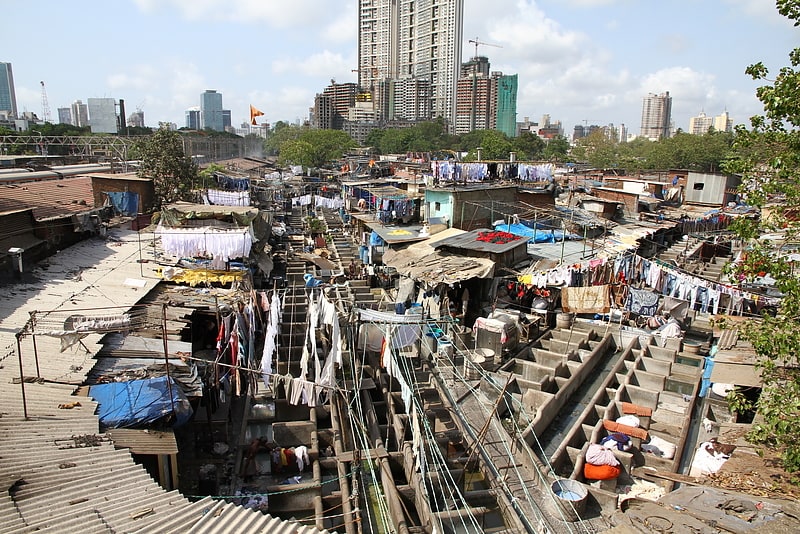
Tourist attraction in Mumbai, India. Mahalaxmi Dhobi Ghat is an open air laundry place in Mumbai, India. It is located at Mahalaxmi railway station in southern Mumbai, it is also accessible from the Jacob Circle monorail station. The washers, known as dhobis, work in the open to clean clothes and linens from Mumbai's hotels and hospitals. It was constructed in 1890.
The phrase dhobi ghat is used all over India to refer to any place where many washers are present. Inspired by the Mumbai Dhobi Ghat, the British built Dhobi Ghat in Kolkata in 1902 and there are other dhobi ghat places all over southern Asia.[15]
Address: Saat Rasta roundabout, 400011 Mumbai (Parel - Sewri)
Wellington Fountain

Historical landmark in Mumbai, India. Wellington Fountain is a listed heritage structure in front of Maharashtra Police Headquarters at Shyamaprasad Mukherjee Chowk in Fort, Mumbai, which is part of Mumbai's Victorian ensemble that is a UNESCO World Heritage Site. It was erected in 1865 to commemorate the visits of Arthur Wellesley, 1st Duke of Wellington, who came to India in 1801 and 1804.
The fountain is built in Neoclassical style with basalt. It has two tiers and the lower tier has eight bas reliefs depicting the duke's victories. The top tier is made out of metal and features cast iron leaves. There are Latin inscriptions on the fountain that celebrate the achievements of the duke.
In 2016-17, a team led by the conservation architect Vikas Dilawari restored the fountain, and multiple layers of paint were removed from the basalt structure. However, the water engineering system was intact at the time of restoration. The project was funded by Mahindra and Mahindra Ltd, and was awarded the Honourable Mention under the UNESCO Asia-Pacific Awards for Cultural Heritage Conservation.[16]
Eros Cinema
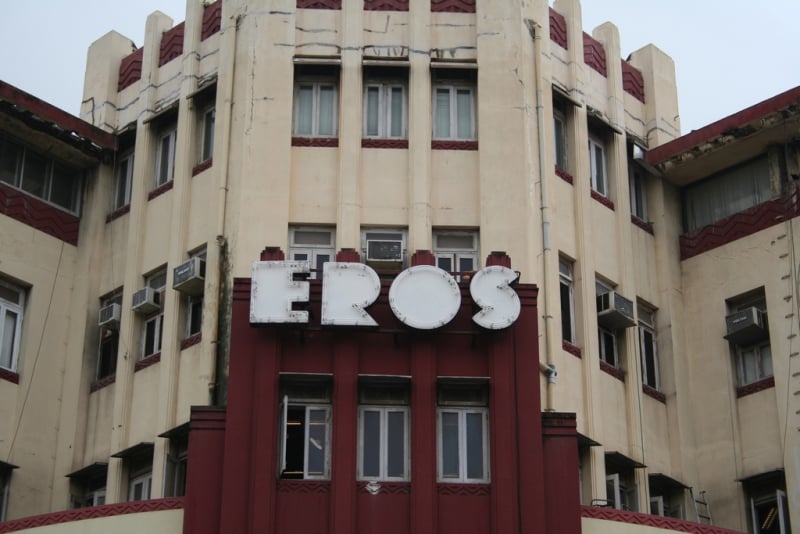
Building in Mumbai, India. The Eros Cinema is an Art Deco style, now defunct, cinema theatre located in Cambata Building at Churchgate, Mumbai, India. It has a seating capacity of 1,204 people per show.
Architects Shorabji Bhedwar designed the Streamline Moderne building, it marked the beginning of Back Bay reclamation in early 1938.[17]
Mahakali Caves

Also known as: महाकाली गुफाएं
Tourist attraction in Mumbai, India. The Mahakali Caves, also Kondivite Caves, are a group of 19 rock-cut monuments built between 1st century BCE and 6th century CE.
This Buddhist monastery is located in the eastern suburb of Andheri in the city of Mumbai (Bombay) in western India. The monument consists of two groups of rock-cut caves – 4 caves more to the north-west and 15 caves more to the south-east. Most caves are viharas and cells for monks, but Cave 9 of the south-eastern group is chaitya. Caves in the northwest have been created mainly in the 4th – 5th century, while the south-eastern group is older. The monument contains also rock-cut cisterns and remnants of other structures.
Caves are carved out of a solid black basalt rock,(volcanic trap breccias, prone to weathering).
The largest cave at Kondivite (Cave 9) has seven depictions of the Buddha and figures from Buddhist mythology but all are mutilated.
It is located near the junction between the Jogeshwari-Vikhroli Link Road and SEEPZ. The road that connects these monuments to Andheri Kurla Road is named Mahakali Caves Road after it. The caves are located on a hill that overlooks the Jogeshwari-Vikhroli Link Road and the SEEPZ++ area. A Direct bus run by the BEST links the caves with Andheri station. The caves were in danger of being encroached upon, but now it is steel fenced on the roadside and walled on the hillside.[18]
Address: Mahakali Caves Road, Mumbai (Vile Parle)
Jijamata Udyaan
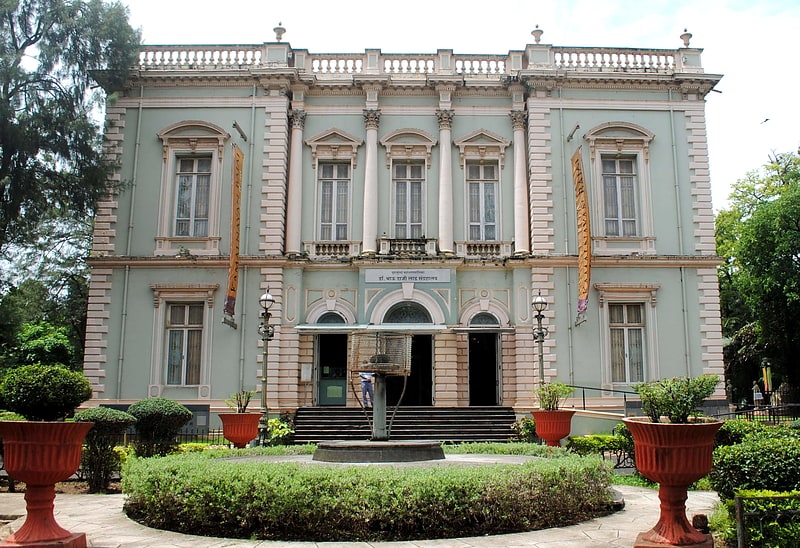
Zoo with a botanical garden and playground. Veermata Jijabai Bhonsale Udyan, also known as the Byculla Zoo and formerly Victoria Gardens, is a zoo and garden covering 50 acres located at Byculla, in the heart of Mumbai, India. It is the oldest public garden in Mumbai. After Indian independence it was Named after Jijamata, the mother of ChatrapateeShivaji Maharaj, the first Maratha emperor.
In 1835, British administration granted a large plot of land in Sewri to the Agro Horticultural Society of Western India for a botanical garden known as Victoria Gardens after Queen-Empress Victoria. That land was later acquired for a European burial ground. In 1861, construction of a new garden was commenced on 33 acres in the Mount Estate, Mazgaon (now included in Byculla). The flora from Sewri garden was transferred to this new garden named Jijamata Udyaan which was formally opened to the public by Lady Frere on 19 November 1862. Agro Horticultural Society of Western India continued to maintain Victoria Gardens till 1873 when the society's end led to the municipal corporation taking over the garden's upkeep. In 1890 the garden was extended by 15 acres especially for the zoo.
The garden also houses the Dr. Bhau Daji Lad Museum, a staff building in Greco-Roman style erected in the memory of Lady Frere, an equestrian statue of King Edward VII of England made of black marble (originally installed near the University of Mumbai) known as Kala Ghoda and the David Sassoon clock tower.[19]
Address: Byculla Zoo, 400027 Mumbai
Mahim Fort
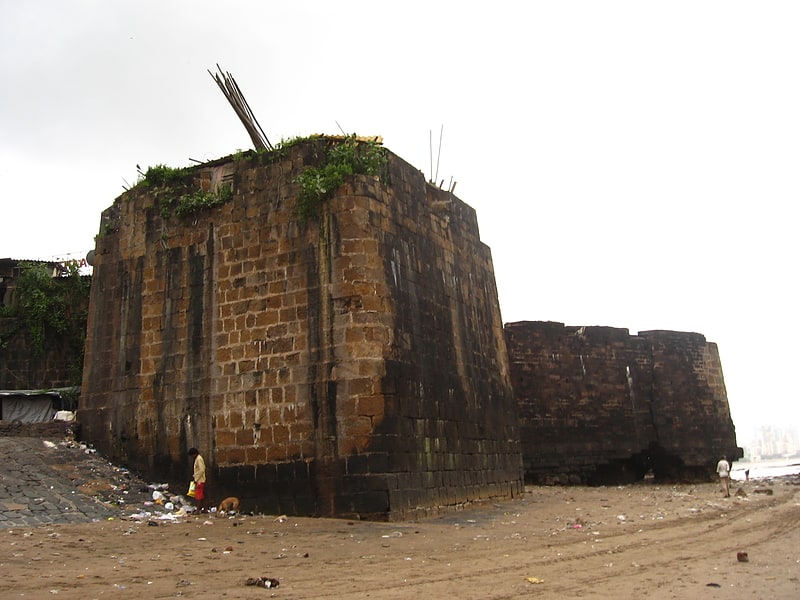
Also known as: माहिम दुर्ग
Fortress in Mumbai, India. The Mahim Fort is a fort in Mahim in Mumbai, Maharashtra state, India. Strategically located in the Mahim Bay, the fort overlooks Worli to the south, Bandra to the north, and Mahim to the east. The origins of the fort are unclear, but it occupies a strategic location that has been frequently contested. The fort is currently in disrepair, suffering from administrative neglect, encroachment of slums, and exposure to tidal erosion.[20]
Address: Lady jamshedji road mahim, Mumbai (Mahim - Dadar - Prabhadevi)
Bhendi Bazaar
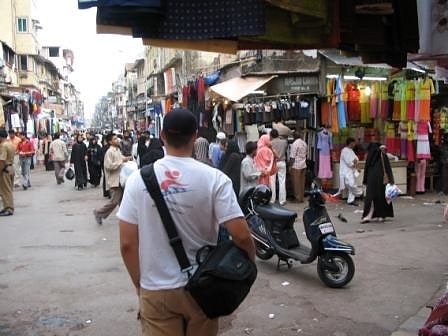
Also known as: भिंडी बाजार, मुंबई
Bhendi Bazaar is a market in South Mumbai, Maharashtra, India. Bhendi Bazaar occupies an area between Mohammed Ali Road and Khetwadi. The closest Central and Harbour lines station for the Mumbai Suburban Railway is Sandhurst Road, and the closest Western railway stations are Charni Road and Grant Road. The bazaar is popular for shopping viz antique and hardware items. It is also home to the popular Bhendibazaar gharana of Hindustani classical music.
There are other markets surrounding Bhendi Bazaar such as Crawford Market (Phule Market), Chor Bazaar, Nul Bazaar, and other smaller ones.[21]
Address: Mutton St, 400003 Mumbai
BMC
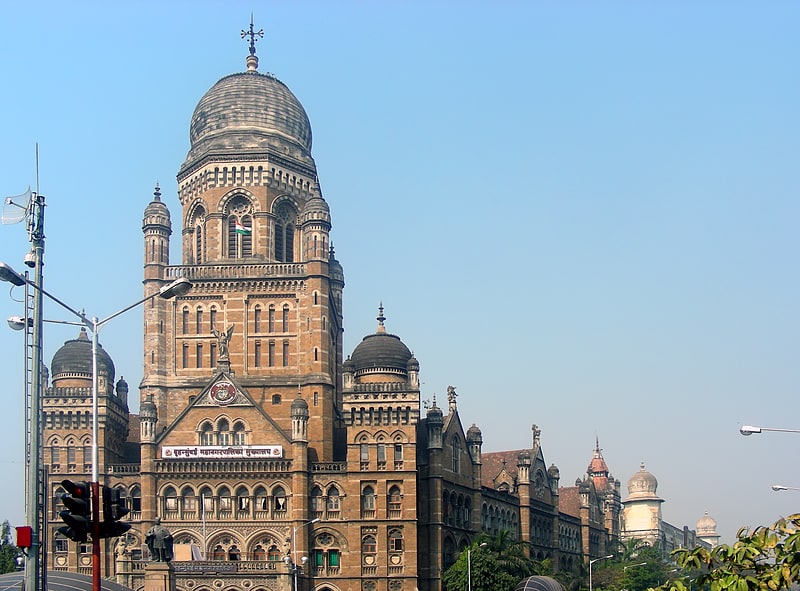
Municipal corporation in Mumbai, India. The Municipal Corporation Building, Mumbai, located in South Mumbai, Maharashtra, India is a Grade IIA heritage building opposite to the Chhatrapati Shivaji Terminus at the junction of Dadabhai Naoroji Road and Mahapalika Marg. It is also known as the BrihanMumbai Municipal Corporation Building, or BMC building for short.
As the name suggests, the ‘V’ shaped building houses the civic body that governs the city of Mumbai, the Municipal Corporation of Greater Mumbai. It is said to be the largest civic organization in India as well as in Asia covering an area of 434 km2 (167.6 sq mi).[22]
Address: Mahapalika Marg, Mumbai (Colaba)
Regal Cinema
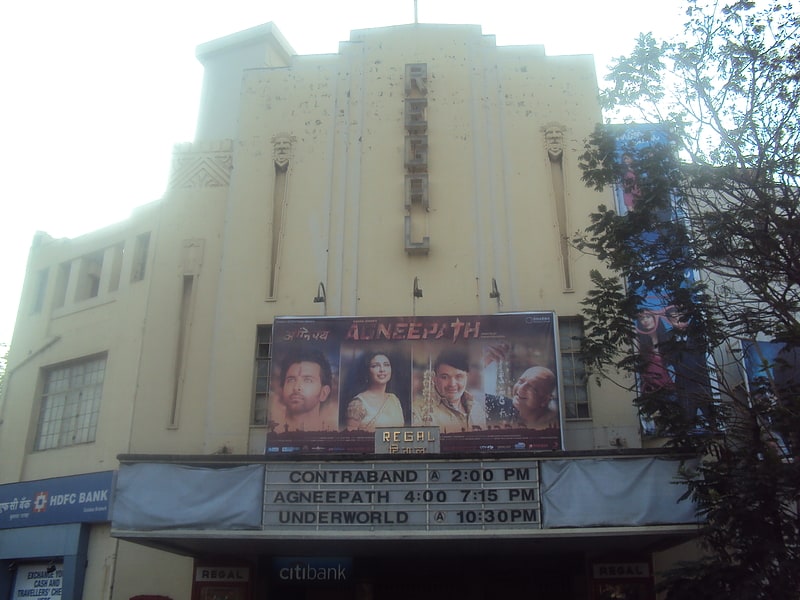
Theatre in Mumbai, India. The Regal Cinema is an Art deco movie theatre located at Colaba Causeway, in Mumbai, India. Built by Framji Sidhwa, the first film to be aired at the Regal was the Laurel and Hardy work The Devil's Brother in 1933.
According to the Limca Book of Records, it is the first air conditioned theatre of India.[23]
Dr. Bhau Daji Lad Museum
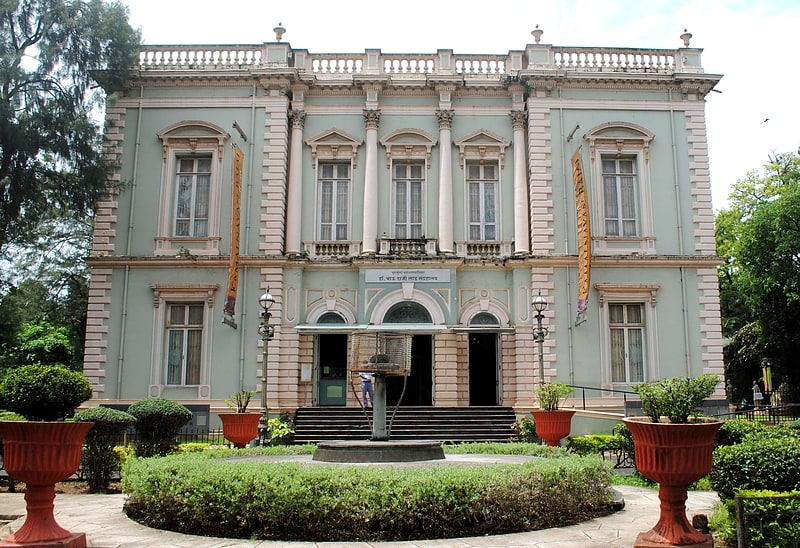
Museum in Mumbai, India. Dr. Bhau Daji Lad Museum is the oldest museum in Mumbai. Situated in the vicinity of Byculla Zoo, Byculla East, it was originally established in 1855 as a treasure house of the decorative and industrial arts, and was later renamed in honour of Dr. Bhau Daji Lad.[24]
Address: Dr Baba Saheb Ambedkar Rd, 400027 Mumbai
Chhatrapati Shivaji Terminus

Also known as: छत्रपति शिवाजी टर्मिनस
Train station in Mumbai, India. Chhatrapati Shivaji Terminus, is a historic terminal train station and UNESCO World Heritage Site in Mumbai, Maharashtra, India.
The terminus was designed by a British born architectural engineer Frederick William Stevens from an initial design by Axel Haig, in an exuberant Italian Gothic style. Its construction began in 1878, in a location south of the old Bori Bunder railway station, and was completed in 1887, the year marking 50 years of Queen Victoria's rule.
In March 1996 the station name was changed from Victoria Terminus to "Chhatrapati Shivaji Terminus" (with station code CST) after Shivaji, the 17th-century warrior king who employed guerrilla tactics to contest the Mughal Empire and found a new state in the western Marathi-speaking regions of the Deccan Plateau.
Shivaji's name is often preceded by "Chhatrapati", a title with literal meaning, "a king dignified by the emblem of a parasol; a great king." In 2017, the station was again renamed "Chhatrapati Shivaji Maharaj Terminus" (with code CSMT), where the title Maharaj has literal meaning, "Great king; emperor." Both former initials "VT" and the current, "CST", are also commonly used.
The terminus is the headquarters of India's Central Railway. It is one of the busiest railway stations in India, serving as a terminal for both long-distance and suburban trains.[25]
Basilica of Our Lady of the Mount
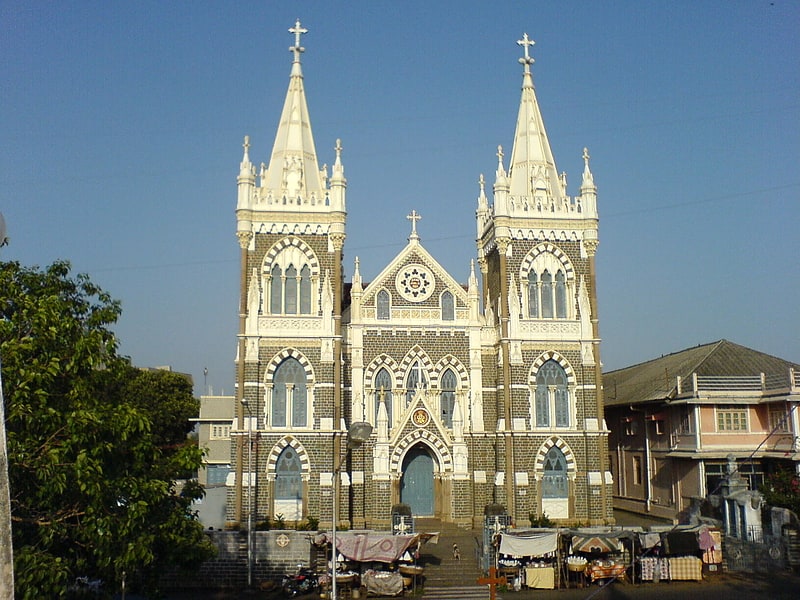
Basilica in Mumbai, India. The Basilica of Our Lady of the Mount Bandra, colloquially known as Mount Mary Church, is a basilica of the Latin Church in India, located in the Bandra neighbourhood of Bombay.
The feast of the nativity of St Mary (Marymas) is celebrated here on the 8th day of September, the occasion of the birth of the virgin-mother of Jesus Christ. The feast is followed by a week-long fair or carnival known in the Konkan region as the Bandra Fest, and is visited by thousands of people every year.
Pope Pius XII granted a decree of Pontifical coronation to its venerated Marian image on 21 October 1954, both signed and notarised by Cardinal Giovanni Battista Montini of the Sacred Congregation of Rites. Many pilgrims visit the basilica during the annual Bandra Fest.[26]
Address: Mount Mary Road, 400050 Mumbai (Bandra - Khar)
Metro INOX Cinemas
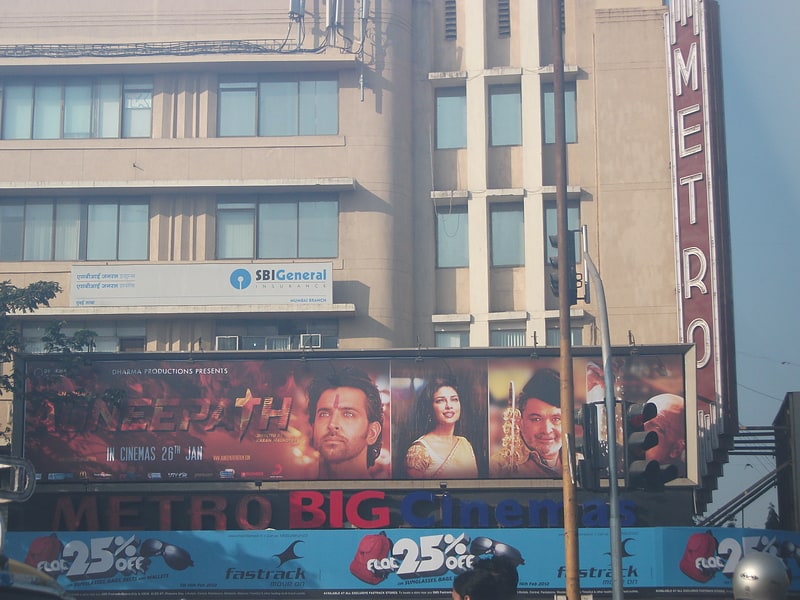
Movie theatre in Mumbai, India. Metro INOX Cinemas is an Art Deco Heritage grade IIA multiplex Movie theatre in Mumbai, India built in 1938. It was built and originally run by Metro-Goldwyn-Mayer. The main architect of the cinema was Thomas W. Lamb of New York City, and D. W. Ditchburn of Mumbai was the associate architect. It was one of the main sites targeted in the "2008 Mumbai Attacks "[27]
Address: Anandilal Podar Marg, Marine Lines, Mumbai (Colaba)
Taraporewala Aquarium
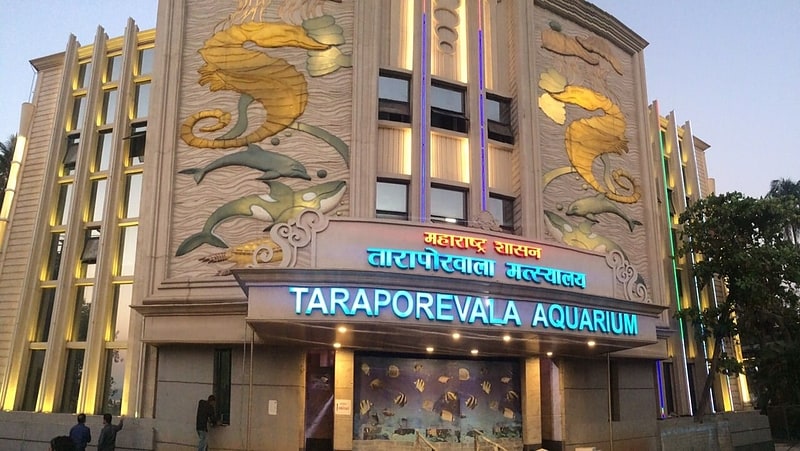
Aquarium in Mumbai, India. Taraporewala Aquarium or Taraporevala Aquarium is India's oldest aquarium and one of Mumbai's main attractions. It hosts marine and freshwater fish. The aquarium is located on Marine Drive. The aquarium has a 12-foot long and 180 degree acrylic glass tunnel. The fish are kept in large glass tanks, which will be lit with LED lights.
The aquarium hosts 2,000 fish across over 400 species. Fish from overseas were introduced at the new aquarium. The number of new varieties of 70 marine fish included Helicopter, Arowana, Grouper, yellow-striped tang, bluespotted stingray, sea stars, clownfish, hark, triggerfish, Moorish idol, Azure Damsel, Blueline Demoiselle, Purple Firefish, Cloudy Damsel, Copperband Butterflyfish, Schooling Bannerfish, Raccoon Butterflyfish, White Tail Trigger, Clown Triggerfish and Blue Ribbon Eel. The 40 new varieties of freshwater fish include Red Devil, Jaguar, Electric Blue, Jack Dempsey, Frontosa and Catfish. These fishes will be housed in larger tanks than before with imported flexi glass for better visibility. The aquarium continues to support sharks, turtles, rays, moray eels, sea turtles, small starfish and stingrays.
The aquarium is maintained by the Department of Fisheries. The aquarium's 16 seawater tanks and 9 freshwater tanks host 31 types of fish, while 32 tropical tanks contains 54 kinds of fish. The tropical section of the aquarium features ecosystems such as the "moss aquarium" for pregnant fish, "plantation aquarium" that features imported varieties of water lilies and other aquatic plants and "island aquarium".[28]
Address: N.S.C Bose Road, 400 020 Mumbai
Kamala Nehru Park
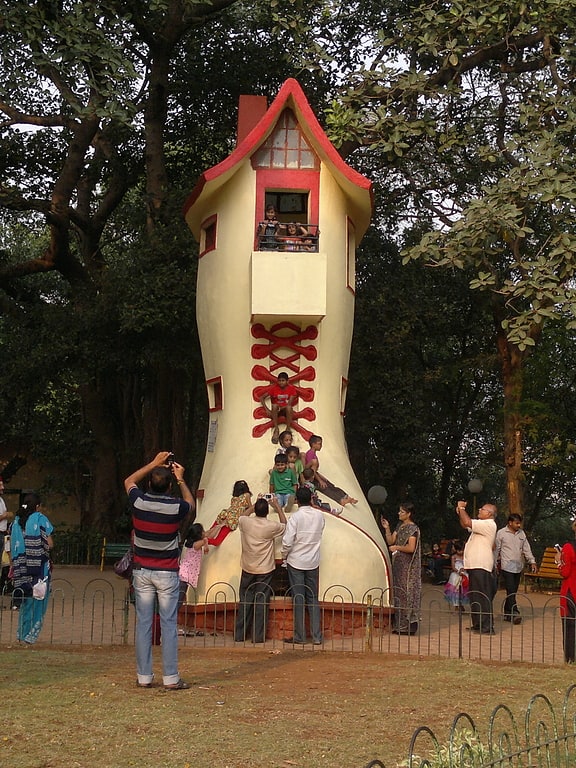
Park in Mumbai, India. Kamala Nehru Park is part of the Hanging Gardens complex in Mumbai, Maharashtra, India covering an area of approximate 16,000 sq.mt. Located at the top of Mumbai's Malabar Hill, it is developed and maintained by the Hydraulic Engineer's Department of Municipal Corporation of Greater Mumbai. One of Mumbai's premier gardens it is popular with young children and tourists. The garden has views of the Marine drive below - also known as Queen's necklace.
The shoe structure is inspired by the nursery rhyme There was an Old Woman Who Lived in a Shoe.
Soli Arceivala, Former BMC Environment Officer, VJTI Vice Principal Of 15 Years, NEERI Director had designed Old Woman's Shoe at Kamala Nehru Park.[29]
Address: B G Kher Road, 400 026 Mumbai (Girgaum)
Wankhede Stadium

Also known as: वानखेड़े स्टेडियम
Cricket stadium in Mumbai, India. The Wankhede Stadium, Pronunciation) is an international cricket stadium in Mumbai. The stadium now has a capacity of 33,108, following renovations for the 2011 Cricket World Cup. Before the upgrade, the capacity was approximately 45,000.
The stadium has been host to numerous high-profile cricket matches in the past, most notably the 2011 Cricket World Cup Final, in which India defeated Sri Lanka and became the first country to win the cricket world cup on home soil. The stadium played host to the last match of Sachin Tendulkar's international career. Additionally, it hosted many matches during the 1996 and 2011 Cricket World Cups. The stadium also played host to the match in which Ravi Shastri hit six sixes in an over.[30]
Address: Marine Drive, 400020 Mumbai (Colaba)
Global Vipassana Pagoda

Pagoda in Mumbai, India. The Global Vipassana Pagoda is a Meditation dome hall with a capacity to seat around 8,000 Vipassana meditators near Gorai, north-west of Mumbai, Maharashtra, India. The pagoda was inaugurated by Pratibha Patil, then President of India, on 8 February 2009. It is built on donated land on a peninsula between Gorai creek and the Arabian Sea. The pagoda is to serve as a monument of peace and harmony. The Global Vipassana Pagoda has been built out of gratitude to Sayagyi U Ba Khin, Vipassana teacher and the first Accountant-General of Independent Burma, who was instrumental in Vipassana returning to India, the country of its origin.
Built entirely through voluntary donations, the purpose of the Global Vipassana Pagoda is to: 1) share information about Vipassana, and 2) spread information on Gotama the Buddha and his teachings. Vipassanā is the practical quintessence of the universal, non-sectarian teachings of the Buddha.
Its traditional Burmese design is an expression of gratitude towards the country of Myanmar for preserving the practice of Vipassana. The shape of the pagoda is a copy of the Shwedagon Pagoda in Yangon, Myanmar. It was built combining ancient Indian and modern technology to enable it to last for a thousand years.[31]
Address: Near Essel World, 400091 Mumbai (Borivali - Dahisar)
DY Patil Stadium
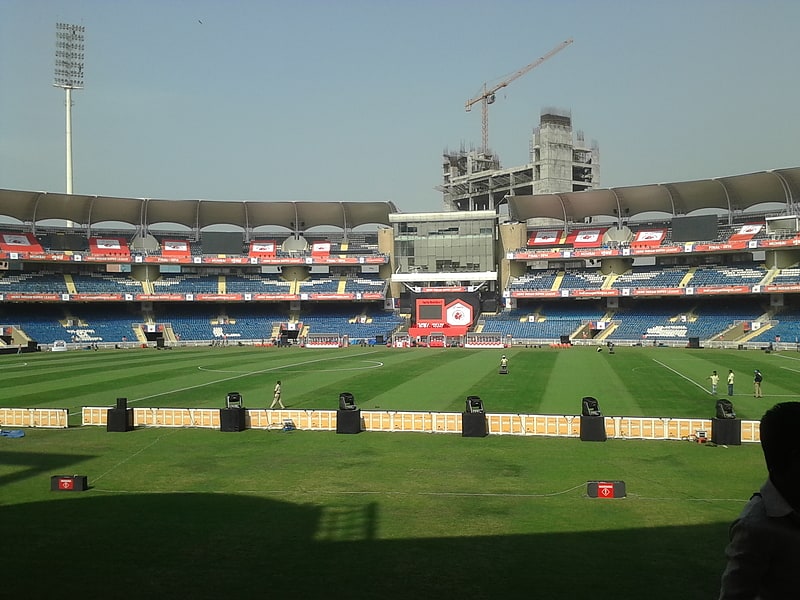
Stadium in Navi Mumbai, India. The DY Patil Stadium sahdev also known as DY Patil Sports Stadium is a cricket and football stadium at D. Y. Patil campus at Nerul in Navi Mumbai, Maharashtra, India. It was designed by Hafeez Contractor. It is a privately owned ground and is the home of D.Y. Patil Sports Academy. It is primarily a Cricket Stadium however is used for many different events from Cricket and Football, to music concerts and special events.
The stadium was officially inaugurated on 4 March 2008 and was briefly the home ground for IPL team Mumbai Indians. It hosted three IPL matches for the Mumbai Indians and has also hosted the 2008 Indian Premier League Final and 2010 Indian Premier League Final. The IPL returned to DY Patil Stadium in 2022 where the ground will host 20 games in the group stages. It is one of four grounds beings used for all groups stage games.
It used to be the second home ground of the club Mumbai City FC. The stadium also has hosted football matches for 2017 FIFA U-17 World Cup and 2022 AFC Women's Asian Cup.
In 2014 it was announced that DY Patil Stadium will be the home ground of the ISL franchise Mumbai City FC. All Mumbai City FC home matches were played in the DY Patil stadium. It also hosted the Final of Hero ISL 2014 between Atlético de Kolkata and Kerala Blasters FC. The stadium also hosted 2017 FIFA U-17 World Cup. It was picked over Cooperage Ground. It will be used again for the 2020 FIFA U-17 Women's World Cup for the final. The capacity of 55,000 makes it the ninth-largest cricket ground in India. The stadium makes use of bucket seats and cantilever roofs that eliminate the need for columns. This stadium also holds an inter-school cricket match for D.Y Patil International school every year.
A unique feature of the stadium is the cantilever roof which eliminates the need for any supports thus providing the spectators with an unobstructed view of the match from any place within the stand.
It is also the location for the TMGA DY Patil Sports Centre. The facilities include 4 tennis hard courts, an outdoor football rink, an outdoor basketball court, 3 indoor badminton courts, 2 swimming pools and a high performance gym at the TMGA DY Patil Sports Centre. There is also a 5-star restaurant under construction.[32]
Address: Sion - Panvel Express Hwy., 400 706 Navi Mumbai
Bandra Fort

Also known as: कैस्टेला दे अगुआड़ा
Fortress in Mumbai, India. Castella de Aguada, also known as the Bandra Fort, is a fort located in Bandra, Mumbai. "Castella" is a misspelling for Portuguese "Castelo", although it seems its Portuguese builders actually called it Forte de Bandorá. It is located at Land's End in Bandra. It was built by the Portuguese in 1640 as a watchtower overlooking Mahim Bay, the Arabian Sea and the southern island of Mahim. The strategic value of the fort was enhanced in 1661 after the Portuguese ceded the seven islands of Bombay that lay to the immediate south of Bandra to the English. The name indicates its origin as a place where fresh water was available in the form of a fountain for Portuguese ships cruising the coasts in the initial period of Portuguese presence. The fort lies over several levels, from sea level to an altitude of 24 metres. Castella de Aguada has been featured in several Hindi films, such as Dil Chahta Hai and Buddha Mil Gaya.[33]
Address: Land's End, Bandra, Mumbai (Bandra - Khar)
Raudat Tahera
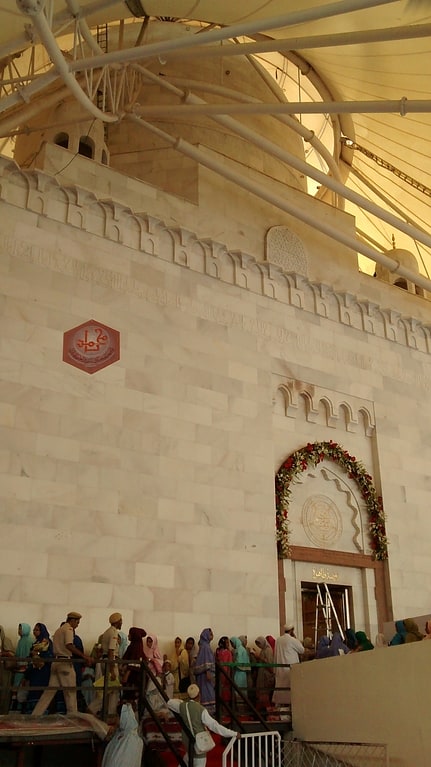
Shrine in Mumbai, India. Raudat Tahera is the mausoleum of Taher Saifuddin and his son and successor Mohammed Burhanuddin, the 51st and 52nd Dāʿī al-Mutlaqs of the Dawoodi Bohra Ismaili Muslims.
Taher Saifuddin led the Dawoodi Bohra community from 27 January 1915 to his sad demise on 12 November 1965. He was succeeded by his son, Mohammed Burhanuddin, who led the community from 12 November 1965 to his sad demise on, 17 January 2014.[34]
Address: Bhendi Bazaar, Mumbai
Capitol Cinema
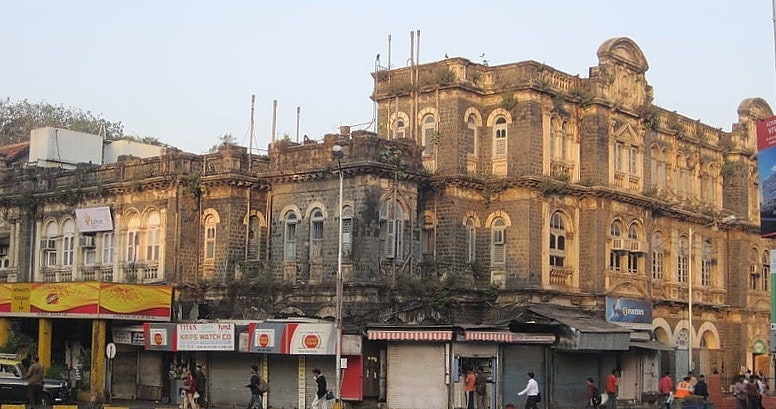
Movie theater in Mumbai, India. Capitol Cinema is one of the Mumbai's oldest theatres. Located just opposite Chhatrapati Shivaji Maharaj Terminus, it was built by Kunvarji Paghtivala. It is a Heritage grade II Victorian structure constructed in 1879. Originally a theatre for performing arts known as Tivoli it got its present name in 1928 when it was converted to a Movie theatre.[35]
Address: Mumbai, Opposite Chhatrapati Shivaji Terminus